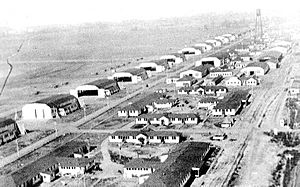Taylor Field (Alabama) facts for kids
Taylor Field was a military airfield located about 11 miles east-southeast of Montgomery, Alabama. It was one of 32 training camps for pilots that the United States set up after joining World War I in April 1917.
Quick facts for kids Taylor FieldGunter Auxiliary Airfield #5 |
|
|---|---|
| Montgomery, Alabama | |

A 1918 aerial view looking northwest along the 16 hangars at Taylor Field
|
|
| Coordinates | 32°18′14″N 086°07′19″W / 32.30389°N 86.12194°W |
| Type | Pilot training airfield |
| Site information | |
| Controlled by | |
| Condition | Agricultural area |
| Site history | |
| Built | 1917 |
| In use | 1917–1946 |
| Battles/wars | World War I World War II |
| Garrison information | |
| Garrison | Training Section, Air Service (World War I) Army Air Force Training Command (World War I) |
History of Taylor Field
World War I Training
The government rented 800 acres of land for Taylor Field starting in November 1917. This was the first military flying base in Alabama. The base was named after Captain Ralph L. Taylor. He was an aviation instructor from Connecticut. Captain Taylor sadly died in a flying accident in August 1917.
By April 1918, several groups of airmen, called service squadrons, arrived at the field. There were also teams for supplies and medical care. Taylor Field became a main flight school. It offered an eight-week course for new pilots. The school could train up to 300 students at a time.
The base had 16 hangars for planes. It also had repair shops, storage buildings, and barracks for soldiers. There was even a hospital. The school used nearly 200 training planes. These included the Curtiss JN-4 "Jenny" and De Havilland DH-4 "Gypsy Month" aircraft. Local repair shops helped keep these planes flying.
Flying lessons officially began on May 2, 1918. The school trained 139 cadets, which are young people training to be officers. Some of these new pilots went on to fight in France during World War I. The airfield closed down in April 1919 after the war ended.
- Training Units at Taylor Field:
- Post Headquarters, Taylor Field - October 1919
- 128th Aero Squadron, April 1918 (later Squadron "A")
- 131st Aero Squadron, March 1918 (later Squadron "B")
- 193d Aero Squadron, March 1918 (later Squadron "C")
- 129th Aero Squadron, April 1918 (later Squadron "D")
- Flying School Detachment (combined Squadrons A-D), November 1918-November 1919
World War II Use
Taylor Field was reopened during World War II. It was known as Gunter Auxiliary Airfield #5. This meant it was an extra landing field. It helped the main flight school at Gunter Army Airfield. After World War II ended, Taylor Field closed again in July 1946.
After the Wars
After World War II, the airfield was sold to private owners. All the old military buildings, like the hangars, were taken down. Today, you can still see hints of the past. For example, parts of an old swimming pool can be seen in aerial photos.
There is a historical marker on Ray Thorington Road. It tells the story of Taylor Field. A neighborhood called Avalon was built in 2005. It covers part of where the airfield used to be. An old dirt road still follows the path of the main entrance to the hangars.



